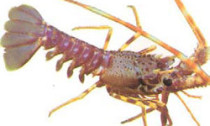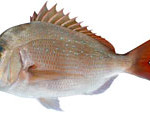
Lobsters, like shrimps and crabs, are decapods – literally meaning 10 legs – and can be found in all of the world’s tropical and sub-tropical seas as well as more temperate waters like these around Tasmania and Southern Australia. They are predatory, nocturnal animals with a vividly decorated coat. They are often numerous locally; they linger in crevices (with their long antennae sticking out) during the day and hunt small benthic organisms at night, but they also feed on organic detritus whenever they happen across it. As with all crustaceans, the lobster moults or sheds its shell to grow.
Lobsters have recently suffered a dramatic demographic decline; intensive fishing has annihilated entire populations, especially where tourism abounds.
The lobster families that you may encounter are the spiny rock lobsters, Palinuridae and the slipper lobsters, Scyllaridae. The true reef lobsters,Nephropidae, with their enlarged pincers on the first pair of legs, tend to prefer warmer waters, but keep looking just in case!
Among the lobsters that will delight you in the region is the eastern rock lobster (Jasus verreauxi), which inhabits the continental shelf along the east coast of Australia, from Tweed Heads in New South Wales, around Tasmania, through to Port MacDonnell in South
Australia. They can be found in holes and crevices around rocky areas and reefs. They have a green body and brownish-orange legs and can have a carapace length of 26cm, reaching up to 100cm when their long antennae are included. This is not to be confused with the southern rock lobster (Jasus edwardsii), which has a red body and which provides the principal lobster fishery in the region.
You may also find the ornate spiny lobster (Panulirus ornatus), a comparative monster at 40cm plus! Ornate lobsters are greenish blue to reddish brown in colour, with orange spines on the head.
In addition, there are the slipper or shovelnose lobsters, (Scyllaridae). Their antennae have evolved into thin, rounded plates, extending in front of a flattened body. They have no long spines or pincers, but instead depend on camouflage and armour for protection. They blend in well with the hard substrate upon which they are often found. By day they hide in caves and crevices and forage at night. The Balmain bug (Ibacus peronii) is dull reddish and it can grow up to 23cm. The Balmain bug is distributed across southern Australia from southern Queensland to central Western Australia. It lives on soft sand and mud at depths between 10 and 250m. This is the most common species of slipper lobster encountered in southeastern Australia where it lives in bays and on the shelf. It is excellent eating but not as popular as rock lobster. The animal’s flat shape enables it to partly bury in the exposed soft sediments where it lives.
Please record all sightings of lobsters, identifying individual species where possible.








Social Profiles